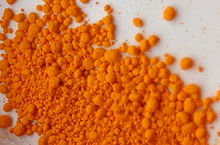This is an old revision of this page, as edited by AvocatoBot (talk | contribs) at 11:52, 25 March 2012 (r2.7.1) (Robot: Adding ro:Oxid de mercur (II)). The present address (URL) is a permanent link to this revision, which may differ significantly from the current revision.
Revision as of 11:52, 25 March 2012 by AvocatoBot (talk | contribs) (r2.7.1) (Robot: Adding ro:Oxid de mercur (II))(diff) ← Previous revision | Latest revision (diff) | Newer revision → (diff)
| |

| |
| Names | |
|---|---|
| IUPAC name Mercury(II) oxide | |
| Other names
Mercuric oxide Montroydite | |
| Identifiers | |
| CAS Number | |
| ChemSpider | |
| ECHA InfoCard | 100.040.580 |
| KEGG | |
| RTECS number |
|
| UN number | 1641 |
| CompTox Dashboard (EPA) | |
InChI
| |
| Properties | |
| Chemical formula | HgO |
| Molar mass | 216.591 g·mol |
| Appearance | Yellow or red solid |
| Odor | odorless |
| Density | 11.14 g/cm |
| Melting point | 500 °C (decomposes) |
| Solubility in water | 0.0053 g/100 mL (25 °C) 0.0395 g/100 mL (100 °C) |
| Solubility | insoluble in alcohol, ether, acetone, ammonia |
| Band gap | 2.2 eV |
| Refractive index (nD) | 2.5 (550 nm) |
| Structure | |
| Coordination geometry | orthorhombic |
| Thermochemistry | |
| Std molar entropy (S298) |
70 J·mol·K |
| Std enthalpy of formation (ΔfH298) |
−90 kJ·mol |
| Hazards | |
| NFPA 704 (fire diamond) |
 |
| Flash point | Non-flammable |
| Related compounds | |
| Other anions | Mercury sulfide Mercury selenide Mercury telluride |
| Other cations | Zinc oxide Cadmium oxide |
| Except where otherwise noted, data are given for materials in their standard state (at 25 °C , 100 kPa).
| |
Mercury(II) oxide, also called mercuric oxide or simply mercury oxide, has a formula of HgO. It has a red or orange color. Mercury(II) oxide is a solid at room temperature and pressure. The mineral form montroydite is very rarely found.
History
In 1774, Joseph Priestley discovered that oxygen was released by heating mercuric oxide, although he did not identify the gas as Oxygen (rather, Priestley called it "dephlogisticated air", as that was the paradigm that he was working under at the time.)
Synthesis


The red form of HgO can be made by heating Hg on oxygen at roughly 350 °C, or by pyrolysis of Hg(NO3)2. The yellow form can be obtained by precipitation of aqueous Hg with alkali. The difference in color is due to particle size, both forms have the same structure consisting of near linear O-Hg-O units linked in zigzag chains with an O-Hg-O angle of 108°.
Structure
Under atmospheric pressure mercuric oxide has two crystalline forms: one is called montroydite (orthorhombic, 2/m 2/m 2/m, Pnma), and the second is analogous to the sulfide mineral cinnabar (hexagonal, hP6, P3221); both are characterized by Hg-O chains. At pressures above 10 GPa both of those structures convert to a tetragonal form.
Uses
HgO is sometimes used in the production of mercury as it decomposes quite easily. When it decomposes, oxygen gas is generated.
It is also used as a material for cathodes for mercury batteries.
Health issues

Mercury oxide is a toxic substance which can be absorbed into the body by inhalation of its aerosol, through the skin and by ingestion. The substance is irritating to the eyes, the skin and the respiratory tract and may have effects on the kidneys, resulting in kidney impairment. In the food chain important to humans, bioaccumulation takes place, specifically in aquatic organisms. The substance is banned as a pesticide in the EU.
Evaporation at 20°C is negligible. HgO decomposes on exposure to light or on heating above 500°C. Heating produces highly toxic mercury fumes and oxygen, which increases the fire hazard. Mercury(II) oxide reacts violently with reducing agents, chlorine, hydrogen peroxide, magnesium (when heated), disulfur dichloride and hydrogen trisulfide. Shock-sensitive compounds are formed with metals and elements such as sulfur and phosphorus.
References
- ^ "Mercury oxide (HgO) crystal structure, physical properties". Vol. 41B. Springer-Verlag. 1999. pp. 1–7. doi:10.1007/b71137. ISBN 978-3-540-64964-9.
{{cite book}}:|work=ignored (help); Missing or empty|title=(help) - ^ Zumdahl, Steven S. (2009). Chemical Principles 6th Ed. Houghton Mifflin Company. p. A22. ISBN 061894690X.
- Almqvist, Ebbe (2003). History of Industrial Gases. Springer. p. 23. ISBN 0306472775.
{{cite book}}: Cite has empty unknown parameters:|month=and|chapterurl=(help) - ^ Greenwood, Norman N.; Earnshaw, Alan (1997). Chemistry of the Elements (2nd ed.). Butterworth-Heinemann. ISBN 978-0-08-037941-8.
- Aurivillius, Karin; Carlsson, Inga-Britt; Pedersen, Christian; Hartiala, K.; Veige, S.; Diczfalusy, E. (1958). "The Structure of Hexagonal Mercury(II)oxide". Acta Chemica Scandinavica. 12: 1297–1304. doi:10.3891/acta.chem.scand.12-1297. Retrieved November 17, 2010.
- Moore, John W. (2005). Chemistry: The Molecular Science. Thomson Brooks/Cole. p. 941. ISBN 0534422012.
{{cite book}}: Cite has empty unknown parameters:|month=and|chapterurl=(help); Unknown parameter|coauthors=ignored (|author=suggested) (help) - Chemicals Regulation Directorate. "Banned and Non-Authorised Pesticides in the United Kingdom". Retrieved 1 December 2009.
{{cite web}}: Cite has empty unknown parameter:|coauthors=(help) - "Mercury (II) oxide". International Occupational Safety and Health Information Centre. Retrieved 2009-06-06.
External links
| Mercury compounds | |||
|---|---|---|---|
| Mercury(I) | |||
| Mercury(II) |
| ||
| Mercury(IV) |
| ||
| Amalgams | |||
| Mercury cations | |||